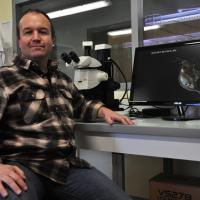
Biodiversity Reading time 5 min
Scott McCairns, an environmental explorer
Published on 07 February 2019
Scott joined the Ecology and Ecosystem Health Unit at INRA Rennes in November 2016 1. “The position was advertised on an evolutionary biology researcher network, and immediately caught my attention.” His interest in sitting the competitive exam sprung from the application of evolutionary issues to the field of ecotoxicology. “Plus, France is a dream come true for a foodie like me!“
Modelled genes: a gauge of water health
The long-term effects of chemical contaminants
In 2017, he launched two major research projects. The first, Evotoxis, looks at the long-term effects of chemical contaminants on daphnia populations. Also known as water fleas, these small crustaceans are used as a water health indicator. “Daphnias are a very interesting model: their very short life cycle makes it possible to grow several generations of them in a laboratory setting. They alternate between sexual and clonal reproduction (or ‘fragmentation’), which is a perfect way to assess the effects of contaminants on the entire expressed genome, and better estimate the transmission of these effects from one generation to another.
The second project – Tremit – focuses on the study of toxicity in one particular component: methylisothiazolinone (MIT), a biocide used in industrial and household cleaning products and in cosmetics and hygiene products. “MIT is a recognized skin sensitizer in humans, but less is known about its environmental effects. The goal is to evaluate what MIT exposure does to gene expression in daphnias, and subsequently study the transgenerational effects of MIT exposure in aquatic ecosystems”.
The next phase of the project involves collecting samples from several populations and establishing lineages in the laboratory. Scott has secured funding for both projects: “It was never a shoo-in. I decided to propose several to at least have a chance! 2017 was a great year for me!” And above all, the result of much hard work in a field he knows well
Evolution and deep-sea fish populations
Exceptional genetic resource
Scott’s career as a scientist took root in his native Canada. After two years studying the evolution of life history traits in trout populations in Halifax, Nova Scotia, he began a doctorate at the Université Laval in Quebec : “my research centred on identifying environmental factors behind genetic and phenotypic structuring in three-spined stickleback populations. That opened the door to evolutionary ecophysiology, which was an emerging field at the time”. After his doctorate, “good timing”, as he calls it, sent him to Helsinki, Finland to continue his work on the three-spined stickleback on a post-doctorate, followed by an independent research project: at the intersection of genetics and the environment, he expanded his bioinformatics skills by working on large data sets. “This research, which is ongoing, allowed me to extend my stay in Finland,” a cultural experience which left a lasting – and surprising – impression : “Finland felt more different to me than a six-month trip to Africa. It’s totally common for a Finnish person to remain silent for hours at a time. I wasn't used to that!” After five years in Helsinki, Scott was struck by wanderlust. The same “good timing” and network of evolutionary biology scientists led him to the Centre for Biology and Management of Populations (CBGP) in Montpellier, France2 in 2015. While working on the Genesis project, he became interested in high-volume sequencing to model the colonisation methods of an invasive species – the Asian cyprinid – a threat to rivers and lakes in Europe. This bridge between ecotoxicology and biological invasion took him to Rennes a few months later.
Working with daphnia today has opened new horizons. “Daphnia produce large amounts of what are called resting eggs, which they lay on sediment in lake or river beds. In bad temperature and light conditions, they don't hatch.” The eggs are an exceptional genetic resource: ancient lakes and ponds can be tested to collect unhatched eggs that are over 300 years old – lineages that are completely free of exposure to chemical products. “A lab in the US successfully resuscitated eggs from the 15th century: it’s like resuscitating a mammoth in ice and comparing both its physiology and morphology to a modern elephant. It’s a fascinating privilege to be able to work on live organisms!” Scott is never short of inspiration.
(1) Ecology and Ecosystem Health joint research unit (INRA-AgroCampusOuest) INRA Bretagne-Normandie
(2) Centre for Biology and Management of Populations (CBGP) joint research unit (INRA-IRD-CIRAD-Montpellier SupAgro), INRA Occitanie-Montpellier
- 44 years old, married
- November 2016 to present: researcher at Ecology and Ecosystem Health joint research unit (INRA-AgroCampusOuest) INRA Brittany-Normandy
- 2015 – 2016: (2) Contract-funded researcher, Centre for Biology and Management of Populations (CBGP) (INRA-IRD-CIRAD-Montpellier SupAgro), INRA Occitanie-Montpellier
- 2012 – 2015: independent research manager, University of Helsinki, Finland
- 2010 – 2012: Post-doctorate, University of Helsinki, Finland at the Centre of Excellence in Evolutionary Genetics and Physiology
- 2006 – 2010: Doctorate at the Université Laval, Québec, Canada
- Hobbies : sports, cooking and eating!
